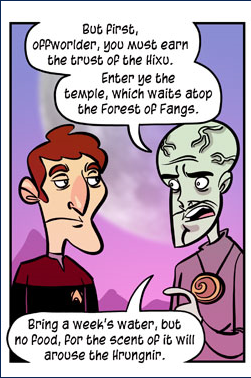Startrekonline.com has given us yet another 'history lesson' from the 25th century as a point of view.
Let's hope more follows in the comming weeks.Starfleet Intelligence continues to gather reports of unrest on Romulus. Praetor Tal’aura enacts food rationing and strict limits on replicator use on the homeworld, saying that the empire’s resources must be reserved to support the military’s campaign against Donatra and the breakaway Imperial Romulan State.
The shortages spark rioting in the capitol of Ki Baratan, and the struggle goes on for two days before the praetor orders troops to intervene. Observers on Romulus suggest that as many as 2,000 people could have died either in the initial riots or at the hands of Romulan troops.
The civil unrest and resistance from Romulan nobles strain Tal’aura’s command of the empire. She calls upon her allies in the Senate to help in stabilizing the government, and they respond by voting to expand the praetor’s powers, giving Tal’aura the power to grant or remove noble titles, which previously was a privilege that only the emperor enjoyed. She also is granted the ability to declare war without Senate approval.
Ambassador Spock returns to Romulus to take his place with the Unificationists. Leaders of the movement say that although they could not win the support of the Federation, they will continue to “wage peace” on Romulus.
On Stardate 60900.31, Fleet Commander Tomalak attacks Donatra’s fleet at Xanitla. Tomalak’s forces are soundly defeated in the battle, and he is dealt a further blow when Admiral Taris and the twelve ships under her command defect to the Imperial side.
The Cardassians make some gains in their efforts to rebuild their war-ravaged planet, signing a new agreement for aid from the Federation and beginning reconstruction of Lakarian City. Excavation of several sites on the planet reveals Hebitian relics, and the publication of these finds sparks a resurgence of interest among Cardassians in ancient religious and cultural practices.
The Oralians, a religious group dating back to the Hebitian civilization that was outlawed by the Cardassian Union, begin openly holding services and seeking adherents among the Cardassian population. The rise of this spiritual movement is opposed by the followers of the True Way, which continues to call for a return to the totalitarian practices of the Union.
The Klingon Empire and the United Federation of Planets are at odds over the Klingon takeover of Khitomer. In a narrow vote, the Federation Council decides not to formally censure the empire for its military action. However, the fact that the matter went to the full Council for a vote is enough of an affront for Qo’noS to temporarily recall its ambassador to the Federation.
Hardliners on the Klingon High Council demand that Martok eject Federation ambassadors from Klingon space. Martok refuses to do so, and then defeats Councilor Qolka in a duel of honor after he accuses Martok of being a “pet desperate for the approval of his Starfleet masters.”
In legal matters, Rear Admiral James Bennett of the Starfleet Judge Advocate General’s office rules that the “Data Decision,” referenced in The Doctor’s legal arguments to keep the mobile emitter, is too narrow to be used in this case. Bennett rules that the precedent can only be applied to prove that The Doctor is not the property of Starfleet, and not to decide whether or not he is a sentient being. The Doctor’s counsel appeals the decision, and analysts predict that the case will continue for some time.
The Soong Foundation, a group affiliated with the Daystrom Institute and dedicated to promoting the rights of artificial life forms, announces that it is beginning research to create a mobile holographic emitter of its own design, with the hopes that the technology can be adapted for civilian use.




 The main difference between the heavy refit and the normal Galaxy class seems to be some reinforcement and increased impulse power, with four impulse engines.
The main difference between the heavy refit and the normal Galaxy class seems to be some reinforcement and increased impulse power, with four impulse engines. 
 This ship bears a strong resemblance to the Galaxy class, but with a radical change to its saucer section. The hull now resembles a shovel. The ship looks a little bit like the
This ship bears a strong resemblance to the Galaxy class, but with a radical change to its saucer section. The hull now resembles a shovel. The ship looks a little bit like the 













